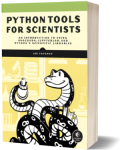Python Tools for Scientists
Data Science
Book Details
Book Title
Python Tools for Scientists
Author
Lee Vaughan
Publisher
No Starch Press, Inc
Publication Date
2023
ISBN
9781718502673
Number of Pages
980
Language
English
Format
File Size
9.4MB
Subject
data-science
Table of Contents
- Cover Page
- Title Page
- Copyright Page
- Dedication
- About the Author
- About the Technical Reviewer
- BRIEF CONTENTS
- CONTENTS IN DETAIL
- ACKNOWLEDGMENTS
- INTRODUCTION
- PART I: SETTING UP YOUR SCIENTIFIC CODING ENVIRONMENT
- Chapter 1. INSTALLING AND LAUNCHING ANACONDA
- About Anaconda
- Installing Anaconda on Windows
- Installing Anaconda on macOS
- Installing Anaconda on Linux
- Getting to Know Anaconda Navigator
- Summary
- Chapter 2. KEEPING ORGANIZED WITH CONDA ENVIRONMENTS
- Understanding Conda Environments
- Working with Conda Environments Using Navigator
- Working with Conda Environments Using the Command Line Interface
- Summary
- Chapter 3. SIMPLE SCRIPTING IN THE JUPYTER QT CONSOLE
- Installing seaborn
- Installing and Launching the Jupyter Qt Console Using Navigator
- Installing and Launching the Jupyter Qt Console Using the CLI
- The Qt Console Controls
- Summary
- Chapter 4. SERIOUS SCRIPTING WITH SPYDER
- Installing and Launching Spyder with Anaconda Navigator
- Installing and Launching Spyder Using the CLI
- Launching Spyder from the Start Menu
- Configuring the Spyder Interface
- Using Spyder with Environments and Packages
- Using Project Files and Folders
- The Help Pane
- The IPython Console
- The Editor Pane
- The Code Analysis Pane
- The Variable Explorer Pane
- The Profiler Pane
- The Debugger Pane
- Summary
- Chapter 5. JUPYTER NOTEBOOK: AN INTERACTIVE JOURNAL FOR COMPUTATIONAL RESEARCH
- Installing Jupyter Notebook
- Your First Jupyter Notebook
- Getting Help
- Using Notebook Extensions
- Working with Widgets
- Sharing Notebooks
- Turning Notebooks into Slideshows
- Summary
- Chapter 6. JUPYTERLAB: YOUR CENTER FOR SCIENCE
- When to Use JupyterLab Instead of Notebook?
- Installing JupyterLab
- Building a 3D Astronomical Simulation
- Taking Advantage of the JupyterLab Interface
- Using the Text Editor
- Using JupyterLab Extensions
- Sharing
- Summary
- PART II: A PYTHON PRIMER
- Chapter 7. INTEGERS, FLOATS, AND STRINGS
- Mathematical Expressions
- Error Messages
- Data Types
- Summary
- Chapter 8. VARIABLES
- Variables Have Identities
- Assigning Variables
- Naming Variables
- Getting User Input
- Using Comparison Operators
- Summary
- Chapter 9. THE CONTAINER DATA TYPES
- Tuples
- Lists
- Sets
- Dictionaries
- Summary
- Chapter 10. FLOW CONTROL
- The if Statement
- Loops
- Handling Exceptions
- Tracing Execution with Logging
- Summary
- Chapter 11. FUNCTIONS AND MODULES
- Defining Functions
- Functions and the Flow of Execution
- Advanced Function Topics
- Modules
- Summary
- Chapter 12. FILES AND FOLDERS
- Creating a New Spyder Project
- Working with Directory Paths
- Working with Text Files
- Working with Complex Data
- Summary
- Chapter 13. OBJECT-ORIENTED PROGRAMMING
- When to Use OOP
- Creating a New Spyder Project
- Defining the Frigate Class
- Defining a Guided-Missile Frigate Class Using Inheritance
- Objects Within Objects: Defining the Fleet Class
- Reducing Code Redundancy with Dataclasses
- Making a Class Module
- Summary
- Chapter 14. DOCUMENTING YOUR WORK
- Comments
- Docstrings
- Summary
- PART III: THE ANACONDA ECOSYSTEM
- Chapter 15. THE SCIENTIFIC LIBRARIES
- The SciPy Stack
- A General Machine Learning Library: scikit-learn
- The Deep Learning Frameworks
- The Computer Vision Libraries
- The Natural Language Processing Libraries
- The Helper Libraries
- Summary
- Chapter 16. THE INFOVIS, SCIVIS, AND DASHBOARDING LIBRARIES
- InfoVis and SciVis Libraries
- Dashboards
- Choosing a Plotting Library
- Summary
- Chapter 17. THE GEOVIS LIBRARIES
- The Geospatial Libraries
- Choosing a GeoVis Library
- Summary
- PART IV: THE ESSENTIAL LIBRARIES
- Chapter 18. NUMPY: NUMERICAL PYTHON
- Introducing the Array
- Manipulating Arrays
- Doing Math Using Arrays
- Reading and Writing Array Data
- Summary
- Chapter 19. DEMYSTIFYING MATPLOTLIB
- Anatomy of a Plot
- The pyplot and Object-Oriented Approaches
- Using the pyplot Approach
- Using the Object-Oriented Style
- Styling Plots
- Summary
- Chapter 20. PANDAS, SEABORN, AND SCIKIT-LEARN
- Introducing the pandas Series and DataFrame
- The Palmer Penguins Project
- Summary
- Chapter 21. MANAGING DATES AND TIMES WITH PYTHON AND PANDAS
- Python datetime Module
- Time Series and Date Functionality with pandas
- Summary
- APPENDIX. ANSWERS TO THE “TEST YOUR KNOWLEDGE” CHALLENGES
- INDEX
